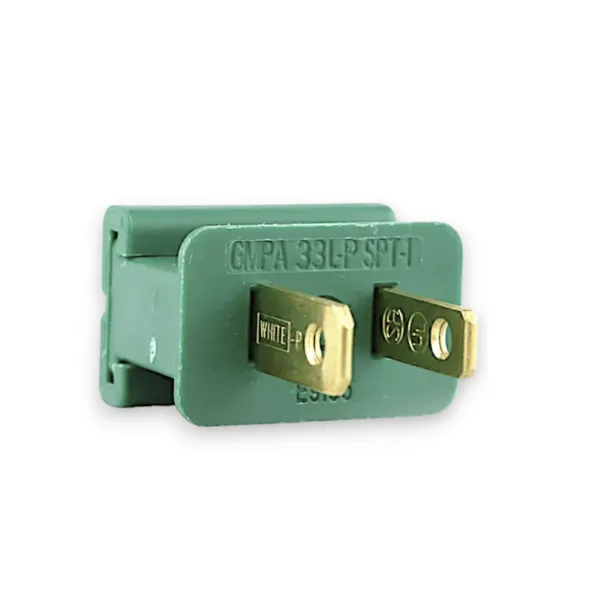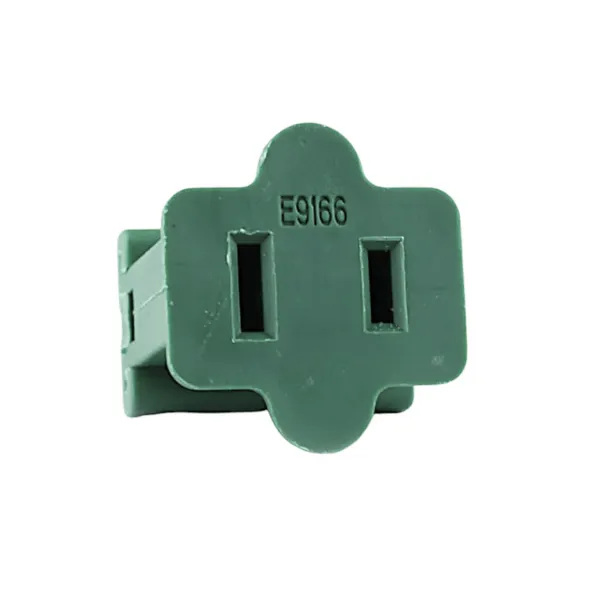Wholesale Pricing Presale Christmas Lights Plugs
Pre-Season Wholesale Gilbert Male Plugs - 1000/Case
As Low As $0.44 per Plug
When it comes to building your own custom Christmas light strings or extension cords, the Gilbert Male Zip Plugs are the best choice. Engineered for durability, these male zip plugs are designed to withstand cold weather, ensuring that the prongs remain straight and reliable even in the harshest winter conditions. Perfect for use with zip cord, these plugs are essential for any professional or DIY Christmas lighting project. Available in SPT-1 or SPT-2, depending on color.
Key Features:
2-Prong Polarized Plug: The 2-prong design provides a secure and stable connection, with polarization for added safety, ensuring your custom Christmas lights work flawlessly.
Heavy-Duty Plastic Construction: Constructed from high-quality, heavy-duty plastic, these plugs are built to last, providing reliable performance for both indoor and outdoor Christmas lighting installations.
Pre-Season Wholesale Gilbert Female Plugs (with knockout tabs) - 1000/Case
As Low As $0.44 per Plug
For creating reliable and custom Christmas light strings or extension cords, the Female Gilbert Zip Plugs with Knockout Tab are the ideal solution. Engineered for durability, these female zip plugs outperform others, with prongs that won't bend even in cold weather. These plugs are perfect for connecting Christmas light strands end to end or for crafting your own custom extension cords with zip cord wire.
Key Features:
Heavy-Duty Plastic Construction: Constructed from high-quality, heavy-duty plastic, these plugs are built to last, providing reliable performance for both indoor and outdoor Christmas lighting installations.
Pre-Season One Plugs SPT-1 - 1000/Case
As Low As $0.40 per Plug
The One Plug simplifies your Christmas light installation by connecting two wires directly, without the need for separate male and female plugs. This design saves time and makes setup faster and more efficient. Made with durable plastic and strong prongs, it's built to last through the season, making it a reliable choice for any lighting project. Perfect for anyone looking to streamline their holiday light displays with ease and reliability.
Key Features:
Heavy-Duty Plastic Construction: Constructed from high-quality, heavy-duty plastic, these plugs are built to last, providing reliable performance for both indoor and outdoor Christmas lighting installations.
Frequently Asked Questions
What colors do the plugs come in?
Our plugs are available in Green, White, Black, and Brown, allowing you to match your wiring and design seamlessly.
Are the plugs durable for outdoor use?
Yes, the plugs are made from heavy-duty plastic and engineered to withstand cold weather and harsh conditions, making them perfect for indoor and outdoor use.
What is the difference between SPT-1 and SPT-2 plugs?
SPT-1 plugs are designed for standard-duty use, while SPT-2 plugs have thicker insulation, making them ideal for heavy-duty installations and more demanding projects.
How do the one-plug connectors work?
The one-plug connectors simplify installation by connecting two wires directly without the need for separate male and female plugs, saving time and effort during setup.
Can I use these plugs to create custom light strings?
Absolutely! These plugs are perfect for creating custom Christmas light strings or extension cords when paired with compatible zip cord wire. They provide reliable, secure connections for professional or DIY projects.
Discover Expert Tips on Our Blog

Simplify Metal Cutting with DeWalt's 20V Max XR
Metal cutting is an essential skill in many DIY projects, especially when it involves precise installations like permanent Christmas lights. A common challenge for many is achieving clean, precise cuts without damaging the material or ending up with a jagged finish. The DeWalt cutter emerges as a practical solution, offering ease and precision. This blog explores how to effectively use the DeWalt cutter, ensuring your metal cuts are not just good, but exceptional.
Unboxing the DeWalt Cutter
Initial Impressions
Upon opening the DeWalt cutter's box, you're greeted with a robust tool that promises durability and precision. The package typically includes a variety of blades—each suited for different materials, but for our purposes, the metal blade is our focus. The heft and grip of the tool suggest it's built for heavy-duty tasks, yet it's designed ergonomically to prevent user fatigue during extended use.
Setting Up
Setting up the DeWalt cutter involves a straightforward process:
1. Blade Installation: Begin by removing the blade guard to access the blade slot. The metal blade included is specifically designed for slicing through metal with minimal burr and heat generation.
2. Securing the Blade: Utilize the provided tool to loosen the retaining bolt, insert the blade, ensuring it's seated properly, and then tighten the bolt. The cutter’s design features a reverse-thread system, which might feel counterintuitive (lefty tighty, righty loosey), but it ensures the blade remains secure under the tool’s high-torque operation.

Preparing for the First Cut
Safety First
Before making the first cut, it's crucial to don safety glasses and sturdy gloves. Metal cutting can produce sharp debris and sparks, which can be hazardous. The DeWalt cutter comes equipped with a blade guard and an emergency stop feature, enhancing safety during operation.
Making the Cut
Marking the metal accurately is key to a perfect cut. Use a permanent marker to draw your cut line clearly. Position the cutter so that the blade aligns with the mark. The tool’s guide light (if available) can help illuminate the line during the cut, ensuring precision.
Practical Cutting Tips
Techniques for Clean Cuts
- Maintain the Tool: Regular maintenance, such as cleaning the blade and lubricating the moving parts, can significantly extend the cutter's life and performance.
- Operate at the Right Speed: Adjust the cutter's speed based on the thickness and type of metal. Slower speeds are better for thicker, harder metals to prevent blade overheating and wear.
Advanced Cutting Techniques
- Angled Cuts: For angled cuts, adjust the blade guard to the desired angle. This feature is incredibly useful for creating joins or decorations in metalwork projects.
- Handling Complex Cuts: For intricate or complex cuts, make several shallow passes to gradually achieve the depth, rather than trying to cut through thick metal in one go.

Post-Cutting Cleanup and Maintenance
Cleaning and Storing the Cutter
After use, it’s important to clean the cutter thoroughly to remove any metal filings or debris. Storing the tool in a dry, clean environment will prevent rust and keep it ready for the next use.
Blade Maintenance
Regularly inspect the blade for signs of wear or damage. Replace the blade if it becomes dull or damaged to maintain cutting efficiency. Keeping a few spare blades on hand is recommended for seamless project continuation.
The DeWalt cutter is an indispensable tool for those requiring precise and clean cuts in metal. By following the above guidelines, users can maximize the tool’s capabilities and ensure their projects turn out both successful and safe.

1. What safety gear should I wear when using the DeWalt cutter?
Answer: Always wear safety glasses to protect your eyes from metal debris and sparks. Sturdy gloves are also recommended to safeguard your hands from sharp edges and heat. Additionally, if you are working in a noisy environment or the tool is particularly loud, consider using ear protection.
2. How do I install a blade on the DeWalt cutter?
Answer: To install a blade on the DeWalt cutter, first remove the blade guard to access the blade slot. Use the included tool to loosen the retaining bolt, insert the metal blade ensuring it's properly seated, and then retighten the bolt. Remember, the cutter uses a reverse-thread system, so you'll tighten to the left and loosen to the right.
3. What should I do if the cut isn't clean or precise?
Answer: Ensure the blade is sharp and properly installed. If issues persist, check that you’re using the correct blade type for the metal you are cutting. Additionally, adjust the speed settings according to the metal’s thickness and hardness. Multiple shallow passes may be necessary for thicker or harder metals.
4. How do I maintain the DeWalt cutter?
Answer: After each use, clean the cutter to remove any metal filings or debris. Regularly check and lubricate moving parts to keep them functioning smoothly. Store the cutter in a dry, clean environment to prevent rust and degradation. Blade maintenance is also crucial; inspect blades regularly for wear and replace them as needed.
5. Can the DeWalt cutter make angled cuts?
Answer: Yes, the DeWalt cutter can be adjusted to make angled cuts. Adjust the blade guard to your desired angle before cutting to achieve clean and precise angled cuts. This feature is useful for creating joins or customized shapes in your metalwork projects.
Copyright ©2025 All Right Reserved website designed by christmaslights.io
Terms of Service / Privacy Policy
Have questions or need assistance?
Contact us at (855)619-LITE





